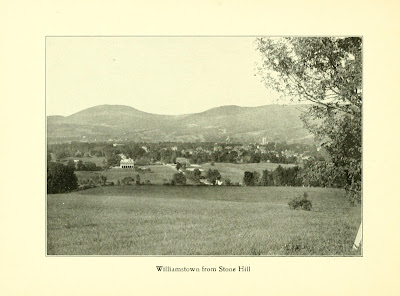Williamstown - "The First Township We Came To"
Lieutenant Israel Bartlett of Haverhill, Massachusetts, had marched north on October 4, 1777 with Captain Nathaniel Marsh and nineteen men from their company, part of Colonel Samuel Johnson's 4th Essex County Regiment of the Massachusetts Militia. Bartlett arrived at Saratoga at the time of the cease-fire, and on the 17th found himself among those ordered to "march in order to take charge of the prisoners, who are to march to Boston." [1] Four days later, on the 21st, he and his men left Saint Croix, New York to march "... 18 miles to Williamstown, through a severe snowstorm." Fortunately for Bartlett and likely due to his status as an officer, in Williamstown he found himself "put up at a very good house." [2]
Massachusetts Militia Private David How was a day behind Bartlett after leaving Saint Croix. Both spent the night of October 20th there, but How and his comrades had waited for the wagons and the sick to catch up, and didn't start their march until noon. That day, which he said was "Very Snowy & wet", they traveling only five miles before stopping for the night somewhere in present-day Hoosick, New York. It was not until the 22nd he left the state of New York and marched to Williamstown, where he said, "We Over Took the Body of Regulars at Williams Town And Stopt there." [3]
Bartlett and Napier remained in Williamstown on the 22nd, Bartlett noting "Halted all day at Williamstown to draw provisions". How also recorded drawing provisions at Williamstown the following morning, before marching south to New Ashford. [4]
British prisoners were apparently given some freedom of movement, the officers at least. British Ensign Thomas Anburey noted that "After we had passed the mountains, the first township we came to was Williamstown, where we soon found how choice we ought to be of our gold..." There inhabitants would not accept hard money from Anburey and his comrades for what they purchased, but would instead exchange paper money for their gold or silver coins, out-bidding each other and paying more than the established rates. [5]
Ensign Thomas Hughes of the British 53rd Regiment of Foot, who had been captured in the raid on Fort Ticonderoga and Mount Independence on September 18th, found himself in Williamstown for several day beginning September 27th. There were fewer houses than in Bennington, Vermont, he recorded, "... but the country is less mountainous, and much better clear'd...". He too enjoyed some freedom of movement, as he attended church, where crowds came to see him and his comrades, and "appear'd surpris'd to find us like themselves." A day earlier he had the chance to explore an abandoned old fort - maybe the West Hoosic Blockhouse - "but time had so reduced the earthen ramparts that I could not trace its form or extent." [6]
The ruined fort observed by Hughes in 1777 was a relic tied to the town's location on the frontier when it was founded around 1750. First known as West Hoosuck, the town's name was changed to Williamstown in 1765, in memory of Colonel Ephraim Williams Jr. who was killed September 8, 1755, north of Fort Edward, New York, in what became known as "The Bloody Morning Scout". Williams, in his will, bequeathed part of his estate for the "support and maintenance of a free school", a school that became Williams College in 1793, on the condition the town's name be changed to Williamstown. [7]
The site of the fort is near the start of a twenty-six point walking tour of Williamstown. Among the stops are two eighteenth century buildings there when Hughes and Anburey passed through. Both now are private buildings, and not open to the public; #14, the 1771 Judah Williams home, and #15, the 1772 Smedley tavern which hosted Benedict Arnold when he was on his way to join Ethan Allen in the taking of Fort Ticonderoga. A third stop, #25, is at a replica of a small house typical of those built Williamstown's first European residents in 1753.
1777 March Blog Home Overnight Stopping Points Towns and Villages Along the Way




Comments
Post a Comment